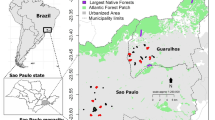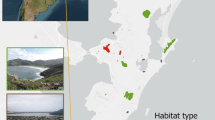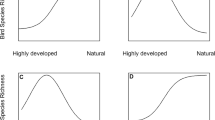Abstract
The relationship between urbanization and different bird diversity facets, such as taxonomic and functional diversity, may depend on the biome where cities are located. We analyzed the impact of urbanization on bird taxonomic and functional diversity in two contrasting biomes of Argentina: desert and subtropical forests. A total of five cities and five natural areas were surveyed in each biome during the breeding season. Taxonomic diversity was measured as the bird species richness in each sampling unit, whereas functional diversity was compared with null models that controlled for differences in species richness. Taxonomic diversity increased in periurban areas located in the desert and in natural areas of forests. Natural areas of the desert biome had similar functional diversity to that of urban areas, whereas natural areas of the forest biome had lower functional diversity than expected for a given number of species. Urban core areas in both biomes were dominated by species that eat seeds and plant materials, and by ground foragers. Natural areas in both biomes were dominated by species that eat invertebrates, and by understory and midstory foragers. Our results showed contrasting relationships between different bird diversity facets and urbanization in desert and forest biomes. Moreover, the results found highlighted the importance of considering different urban habitats in large-scale comparisons and the need for particular management actions in different biomes.



Similar content being viewed by others
Availability of data and material
Data is available under request to authors.
References
Adams CE (2016) Urban wildlife management. CRC Press
Bang C, Faeth SH, Sabo JL (2012) Control of arthropod abundance, richness, and composition in a heterogeneous desert city. Ecol Monogr 82(1):85–100
Barbaro L, Giffard B, Charbonnier Y, van Halder I, Brockerhoff EG (2014) Bird functional diversity enhances insectivory at forest edges: a transcontinental experiment. Div Distrib 20(2):149–159
Batáry P, Kurucz K, Suarez-Rubio M, Chamberlain DE (2018) Non-linearities in bird responses across urbanization gradients: A meta-analysis. Glob Change Biol 24:1046–1054
Benito JF, Escobar MA, Villaseñor NR (2019) Conservación en la ciudad:¿ Cómo influye la estructura del hábitat sobre la abundancia de especies de aves en una metrópoli latinoamericana? Gayana (concepción) 83(2):114–125
Blair RB, Johnson EM (2008) Suburban habitats and their role for birds in the urban–rural habitat network: points of local invasion and extinction? Landscape Ecol 23(10):1157–1169
Blair RB (1996) Land use and avian species diversity along an urban gradient. Ecol Appl 6:506–519
Bock CE, Jones ZF, Bock JH (2008) The oasis effect: response of birds to exurban development in a southwestern savanna. Ecol Appl 18:1093–1106
Chao A, Jost L (2012) Coverage-based rarefaction and extrapolation: standardizing samples by completeness rather than size. Ecology 93(12):2533–2547
Chao A, Ma KH, Hsieh TC (2016) iNEXT (iNterpolation and EXTrapolation) online: Software for interpolation and extrapolation of species diversity. Program and User’s Guide published at http://chao.stat.nthu.edu.tw/wordpress/software_download/
Chiari C, Dinetti M, Licciardello C, Licitra G, Pautasso M (2010) Urbanization and the more-individuals hypothesis. J Animal Ecol 79(2):366–371
Cooke RS, Bates AE, Eigenbrod F (2019) Global trade-offs of functional redundancy and functional dispersion for birds and mammals. Glob Ecol Biogeogr 28(4):484–495
Croci S, Butet A, Clergeau P (2008) Does urbanization filter birds on the basis of their biological traits? Condor 110:223–240
de Castro Pena JC, Martello F, Ribeiro MC, Armitage RA, Young RJ, Rodrigues M (2017) Street trees reduce the negative effects of urbanization on birds. PLoS ONE 12(3):e0174484–e0174484
Díaz S, Cabido M (2001) Vive la différence: plant functional diversity matters to ecosystem processes. Trend Ecol Evol 16(11):646–655
Evans BS, Reitsma R, Hurlbert AH, Marra PP (2018) Environmental filtering of avian communities along a rural-to-urban gradient in Greater Washington, DC, USA. Ecosphere 9(11):e02402
Evans KL, Warren PH, Gaston KJ (2005) Species–energy relationships at the macroecological scale: a review of the mechanisms. Biol Rev 80(1):1–25
Ferreira T, Rasband W (2012) ImageJ user guide: IJ 1.46r. National Institute of Health, USA
Filloy J, Zurita GA, Bellocq MI (2018) Bird diversity in urban ecosystems: The role of the biome and land use along urbanization gradients. Ecosystems 22:213–227
Furlan V, Kujawska M, Hilgert NI, Pochettino ML (2016) To what extent are medicinal plants shared between country home gardens and urban ones? A case study from Misiones, Argentina. Pharm Biol 54(9):1628–1640
Garaffa PI, Filloy J, Bellocq MI (2009) Bird community responses along urban–rural gradients: does the size of the urbanized area matter? Landsc Urban Plan 90:33–41
Grimm NB, Faeth SH, Golubiewski NE, Redman CL, Wu J, Bai X, Briggs JM (2008) Global change and the ecology of cities. Science 319:756–760
Groffman PM, Cavender-Bares J, Bettez ND, Grove JM, Hall SJ, Heffernan JB, Nelson K (2014) Ecological homogenization of urban USA. Front Ecol Environ 12(1):74–81
Hurlbert AH (2004) Species–energy relationships and habitat complexity in bird communities. Ecol Lett 7(8):714–720
Imhoff ML, Tucker CJ, Lawrence WT, Stutzer DC (2000) The use of multisource satellite and geospatial data to study the effect of urbanization on primary productivity in the United States. IEEE Trans Geosc Remote Sens 38(6):2549–2556
Jokimäki J, Kaisanlahti-Jokimäki ML (2003) Spatial similarity of urban bird communities: a multiscale approach. J Biogeogr 30:1183–1193
Jokimäki J, Suhonen J, Jokimäki-Kaisanlahti ML, Carbó-Ramírez P (2016) Effects of urbanization on breeding birds in European towns: Impacts of species traits. Urban Ecosyst 19(4):1565–1577
Kale M, Dudhe N, Ferrante M, Ivanova T, Kasambe R, Trukhanova IS, Lövei GL (2018) The effect of urbanization on the functional and scale-sensitive diversity of bird assemblages in Central India. J Trop Ecol 34(6):341–350
Kark S, Iwaniuk A, Schalimtzek A, Banker E (2007) Living in the city: can anyone become an ‘urban exploiter’? J Biogeogr 34(4):638–651
Kembel SW, Cowan PD, Helmus MR, Cornwell WK, Morlon H, Ackerly DD, Webb CO (2010) Picante: R tools for integrating phylogenies and ecology. Bioinformatics 26:1463–1464
La Sorte FA, Lepczyk CA, Aronson MF, Goddard MA, Hedblom M, Katti M, Williams NS (2018) The phylogenetic and functional diversity of regional breeding bird assemblages is reduced and constricted through urbanization. Divers Distrib 24(7):928–938
Laliberté E, Legendre P (2010) A distance-based framework for measuring functional diversity from multiple traits. Ecology 91:299–305
Laliberté E, Legendre P, Shipley B, Laliberté ME (2014) Package ‘FD.’ Version 1:12
Lepczyk CA, La Sorte FA, Aronson MF, Goddard MA, MacGregor-Fors I, Nilon CH, Warren PS (2017) Global patterns and drivers of urban bird diversity. Ecology and conservation of birds in urban environments. Springer, Cham, pp 13–33
Leveau LM (2013) Bird traits in urban–rural gradients: how many functional groups are there? J Ornithol 154:655–662
Leveau LM (2019) Primary productivity and habitat diversity predict bird species richness and composition along urban-rural gradients of central Argentina. Urban Forest Urban Green 43:126349
Leveau CM, Leveau LM (2006) Ensambles de aves en calles arboladas de tres ciudades costeras del sudeste de la provincia de Buenos Aires, Argentina. Hornero 21:25–30
Leveau CM, Leveau LM (2005) Avian community response to urbanization in the Pampean region, Argentina. Ornitol Neotrop 16:503–510
Leveau LM, Leveau CM (2004) Comunidades de aves en un gradiente urbano de la ciudad de Mar del Plata. Argentina Hornero 19(1):13–21
Leveau LM, Leveau CM (2020) Street design in suburban areas and its impact on bird communities: Considering different diversity facets over the year. Urban Forest Urban Green 48:126578
Leveau LM, Isla FI, Bellocq MI (2018) Predicting the seasonal dynamics of bird communities along an urban-rural gradient using NDVI. Landsc Urban Plan 177:103–113
Leveau LM, Jokimäki J, Kaisanlahti-Jokimäki ML (2017) Scale dependence of biotic homogenisation by urbanisation: a comparison of urban bird communities between central Argentina and northern Finland. European J Ecol 3:1–18
Leveau LM, Zuria I (2017) Flocking the city: Avian demography and population dynamics in urban Latin America. In Avian Ecology in Latin American Cityscapes. Cham: Springer., Pp. 57–77
Lim HC, Sodhi NS (2004) Responses of avian guilds to urbanisation in a tropical city. Landsc Urban Plan 66(4):199–215
MacGregor-Fors I (2010) How to measure the urban-wildland ecotone: redefining ‘peri-urban’areas. Ecol Res 25(4):883–887
Martinez CF, Cantón MA, Juñent FAR (2014) Incidencia del déficit hídrico en el crecimiento de árboles de uso urbano en ciudades de zonas áridas. Caso de Mendoza, Argentina. Interciencia 39(12):890–897
Marzluff JM, Bowman R, Donnelly R (2001) A historical perspective on urban bird research: trends, terms, and approaches. In Avian ecology and conservation in an urbanizing world (pp. 1–17). Springer, Boston, MA
Marzluff JM (2005) Island biogeography for an urbanizing world: how extinction and colonization may determine biological diversity in human-dominated landscapes. Urban Ecosyst 8:157–177
Mateucci SD (2012) Ecorregión Monte de Llanuras y Mesetas, en: Morello J., Mateucci, S., Rodriguez, A. (Eds.), Ecorregiones y complejos ecosistemicos argentinos. Buenos Aires: Orientación Gráfica Editora
McKinney ML (2006) Urbanization as a major cause of biotic homogenization. Biol Conserv 127:247–260
Morelli F, Benedetti Y, Ibáñez-Álamo JD, Jokimäki J, Mänd R, Tryjanowski P, Møller AP (2016) Evidence of evolutionary homogenization of bird communities in urban environments across Europe. Glob Ecol Biogeogr 25:1284–1293
Morelli F, Benedetti Y, Su T, Zhou B, Moravec D, Šímová P, Liang W (2017) Taxonomic diversity, functional diversity and evolutionary uniqueness in bird communities of Beijing’s urban parks: effects of land use and vegetation structure. Urban Forest Urban Green 23:84–92
Oksanen J, Kindt R, Legendre P, O’Hara B, Stevens MHH (2017) The vegan package. Community ecology package. http://cran.r-project.org, http://vegan.r-forge.r-project.org/
Oliveira Hagen E, Hagen O, Ibáñez-Álamo JD, Petchey OL, Evans KL (2017) Impacts of urban areas and their characteristics on avian functional diversity. Front Ecol Evol 5:84
Petchey OL, Evans KL, Fishburn IS, Gaston KJ (2007) Low functional diversity and no redundancy in British avian assemblages. J Anim Ecol 76:977–985
Petchey OL, Gaston KJ (2002) Functional diversity (FD), species richness and community composition. Ecol Lett 5:402–411
Proppe DS, Sturdy CB, St. Clair CC (2013) Anthropogenic noise decreases urban songbird diversity and may contribute to homogenization. Glob Change Biol 19(4):1075–1084
R Development Core Team (2017) R: a language and environment for statistical computing. Massachussetts: R Foundation Project, GNU project
Reynaud PA, Thioulouse J (2000) Identification of birds as biological markers along a neotropical urban–rural gradient (Cayenne, French Guiana), using co-inertia analysis. J Environ Manage 59(2):121–140
Rodrigues AG, Borges-Martins M, Zilio F (2018) Bird diversity in an urban ecosystem: the role of local habitats in understanding the effects of urbanization. Iheringia Sér Zool 108
Rodríguez F, Silva M (2012) Ecorregión Selva Paranaense, en: Morello J., Mateucci, S., Rodriguez, A. (Eds.), Ecorregiones y complejos ecosistemicos argentinos. Buenos Aires: Orientación Gráfica Editora
Sacco AG, Rui AM, Bergmann FB, Müller SC, Hartz SM (2015) Perda de diversidade taxonômica e funcional de aves em área urbana no sul do Brasil. Iheringia Sér Zool 105(3):276–287
Schütz C, Schulze CH (2015) Functional diversity of urban bird communities: effects of landscape composition, green space area and vegetation cover. Ecol Evol 5(22):5230–5239
Şekercioğlu CH (2006) Increasing awareness of avian ecological function. Trend Ecol Evol 21(8):464–471
Şekercioğlu ÇH, Daily GC, Ehrlich PR (2004) Ecosystem consequences of bird declines. Proc Nat Acad Sci 101(52):18042–18047
Shochat E, Warren PS, Faeth SH, McIntyre NE, Hope D (2006) From patterns to emerging processes in mechanistic urban ecology. Trends Ecol Evol 21(4):186–191
Sol D, Bartomeus I, González-Lagos C, Pavoine S (2017) Urbanisation and the loss of phylogenetic diversity in birds. Ecol Lett 20(6):721–729
Suarez-Rubio M, Leimgruber P, Renner SC (2011) Influence of exurban development on bird species richness and diversity. J Ornithol 152:461–471
Swenson NG (2014) Functional and phylogenetic ecology in R. Springer, New York, p 201
Vaccaro A, Filloy J, Bellocq M (2019) What land use better preserves taxonomic and functional diversity of birds in a grassland biome? Avian Conserv Ecol 14(1)
Vale TR, Vale GR (1976) Suburban bird populations in west-central California. J Biogeogr 3:157–165
Weideman EA, Slingsby JA, Thomson RL, Coetzee BT (2020) Land cover change homogenizes functional and phylogenetic diversity within and among African savanna bird assemblages. Landscape Ecol 35(1):145–157
Whelan CJ, Wenny DG, Marquis RJ (2008) Ecosystem services provided by birds. Ann NY Acad Sci 1134(1):25–60
Wilman H, Belmaker J, Simpson J, de la Rosa C, Rivadeneira MM, Jetz W (2014) EltonTraits 1.0: Species-level foraging attributes of the world’s birds and mammals: Ecological Archives E095–178. Ecology 95:2027–2027
Acknowledgements
Financial support was provided by the Agencia Nacional de Promoción Científica y Tecnológica of Argentina, PICT-2015-0978. We thank Carolina Pinto and Andres de Miguel for field assistance and Jorgelina Brasca for editing the English writing. Logistical support and legal permissions were provided by Administración Parques Nacionales (RNE San Antonio), Fundación Temaikén (Reserva Natural Osununú), Reserva Privada Surucuá, Centro de Investigaciones Antonia Ramos and E. Avigliano, Ministerio de Ecología de Recursos Naturales Renovables de la provincia de Misiones, F. J. Castía (Parque Provincial Esmeralda), Pablo Cuello (Reserva Ñacuñan), Andres Castro and Marcela Montané (Mendoza). An anonymous reviewer helped to improve a previous version of the manuscript. The authors dedicate this piece of work to our co-author M.I. Bellocq, dearest colleague and friend who will always be in our hearts and memories.
Funding
Agencia Nacional de Promoción Científica y Tecnológica of Argentina, PICT-2015–0978.
Author information
Authors and Affiliations
Contributions
Conceptualization, L.M.L. and M.I.B.; methodology, L.M.L., A.V., M.I.B.; formal analysis, L.M.L.; investigation, L.M.L., A.V., M.I.B.; resources, L.M.L.; data curation, L.M.L.; writing—original draft preparation, L.M.L.; writing—review and editing, L.M.L.; supervision, L.M.L.; project administration, L.M.L.; funding acquisition, L.M.L.
Corresponding author
Ethics declarations
Ethics approval and consent to participate
Not applicable.
Consent for publication
All authors have consent the publication of the manuscript.
Competing interests
The authors declare no conflict of interest and the funders had no role in the design of the study; in the collection, analyses, or interpretation of data; in the writing of the manuscript; or in the decision to publish the results.
Supplementary Information
Below is the link to the electronic supplementary material.
Rights and permissions
Springer Nature or its licensor holds exclusive rights to this article under a publishing agreement with the author(s) or other rightsholder(s); author self-archiving of the accepted manuscript version of this article is solely governed by the terms of such publishing agreement and applicable law.
About this article
Cite this article
Leveau, L.M., Vaccaro, A.S. & Bellocq, M.I. Urbanization and bird diversity: does the relationship change in deserts and subtropical forests?. Urban Ecosyst 25, 1891–1900 (2022). https://doi.org/10.1007/s11252-022-01269-w
Accepted:
Published:
Issue Date:
DOI: https://doi.org/10.1007/s11252-022-01269-w




